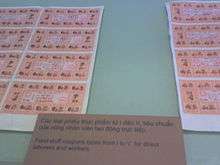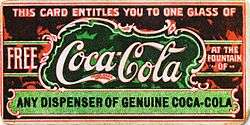Coupon
In marketing, a coupon is a ticket or document that can be redeemed for a financial discount or rebate when purchasing a product.

Customarily, coupons are issued by manufacturers of consumer packaged goods or by retailers, to be used in retail stores as a part of sales promotions. They are often widely distributed through mail, coupon envelopes, magazines, newspapers, the Internet (social media, email newsletter), directly from the retailer, and mobile devices such as cell phones. Since only price conscious consumers are likely to spend the time to claim the savings, coupons function as a form of price discrimination, enabling retailers to offer a lower price only to those consumers who would otherwise go elsewhere. In addition, coupons can also be targeted selectively to regional markets in which price competition is great.
In government, a coupon is a paper certificate used to administer a benefit or permission.
Pronunciation
The word is of French origin, pronounced [kupɔ̃]. In Britain, the United States, and Canada it is pronounced /ˈkuːpɒn/ KOO-pon. A common alternate American pronunciation is /ˈkjuːpɒn/ KEW-pon.[1]
History
Origin

In 1886, The Coca-Cola Company was incorporated in Atlanta, Georgia, with Asa Candler as one of the partners. He transformed Coca-Cola from an insignificant tonic into a profitable business by using advertising techniques. Candler's marketing included having the company's employees and sales representatives distribute complimentary coupons for Coca-Cola.[3] Coupons were mailed to potential customers and placed in magazines. The company gave soda fountains free syrup to cover the costs of the free drinks. It is estimated that between 1894 and 1913 one in nine Americans had received a free Coca-Cola, for a total of 8,500,000 free drinks. By 1895 Candler announced to shareholders that Coca-Cola was served in every state in the United States.[4]
In Australia consumers first came in contact with couponing when a company called Shopa Docket promoted offers and discounts on the back of shopping receipts in 1986.[5]
Types and uses
There are different types of values applied to coupons such as discounts, free shipping, buy-one get-one, trade-in for redemption, first-time customer coupons, free trial offer, launch offers, festival offers, and free giveaways. Similarly, there are different uses of coupons which include: to incentive a purchase, to reduce the price of a particular item or items, provide a free sample, or to help allow marketers better-understand the demographics of their customer.
Function
Coupons can be used to research the price sensitivity of different groups of buyers (by sending out coupons with different dollar values to different groups). In addition, it is generally assumed that buyers who take the effort to collect and use coupons are more price sensitive than those who do not. Therefore, the posted price paid by price-insensitive buyers can be increased, while using coupon discounts to maintain the price for price-sensitive buyers (who would not buy at a higher price).[6]
Grocery coupons
Grocery coupons come in two major types: store coupons and manufacturer's coupons.
Store coupons are coupon-based discounts offered for a particular item or group of items. The issuing store will accept its own "store coupons", but some stores will also accept store coupons that are issued by competitors.
Coupons issued by the manufacturer of a product may be used at any coupon-accepting store that carries that product.
Manufacturer's coupons have the advantage of being currency at a variety of retailers, not just at one store.
Grocery coupons are incentives for people who want to save money, but manufacturer coupons are primarily intended to advertise products and lure new customers with financial incentives. They may also be used to increase the sales of newspapers or other publications. For example, people may purchase multiple copies of a newspaper or magazine in order to use the coupons contained within.
Some grocery stores regularly double the value of a grocery coupon as an incentive to bring customers into their stores. Additionally, stores might hold special events where they will double or triple coupon values on certain days or weeks. Whether or not a specific grocery chain will double or triple coupons usually depends on the original coupon value.[7]
Expiration
Most coupons have an expiration date after which they will not be honored. For example, Christmas coupons are valid only throughout the Christmas week. American military commissaries overseas honor manufacturers coupons for up to six months past the expiration date.[8]
Delivery methods
Customers may get these coupons from various sources, including national newspapers and the Internet, with web sites offering free printable grocery coupons can be printed at home and use them at retail store. Some major grocery chains also produce digital coupons that may be loaded onto the retailer's loyalty card at home, or at a coupon dispensing machine located in store. In 2011, the top five vehicles for distributing consumer packaged goods coupons in the U.S. were: the Free Standing Insert, a coupon booklet distributed through newspapers and other sources (89.4%); in-store distribution (4.2.%); direct mail (2.3%); magazines (1.5%); and coupons distributed on or in product packaging (1.3%). Other distribution methods together accounted for less than 2% of all coupons distributed. There are coupon-providing websites that provide customers with coupons of various stores. These sites accumulate coupons from various sources.
Print media
Clipping coupons from newspapers has been the most popular way to obtain coupons, though Internet and Mobile Phone coupons are gaining wide popularity.
Some retailers and companies use verification methods such as unique barcodes, coupon ID numbers, holographic seals, and watermarked paper as protection from unauthorized copying or use.
Other than newspaper, there are also coupon book publishers and retailers who compile vouchers and coupons into books, either for sale or free.
Internet coupons
Online retailers often refer to coupons as "coupon codes", "promotional codes", "promotion codes", "discount codes", "keycodes", "promo codes", "surplus codes", "portable codes", "shopping codes", "voucher codes", "reward codes", "discount vouchers", "referral codes" or "source codes". Internet coupons typically provide reduced cost or free shipping, a specific dollar, percentage discount or to earn cashback while some offer to encourage consumers to purchase specific products or to purchase from specific retailers. Because paper coupons would be difficult to distribute and redeem, typically secret words or codes are distributed for consumers to type in at checkout. Marketers can use different codes for different channels or groups in order to differentiate response rates.
Mobile coupons
A mobile coupon is an electronic ticket solicited and or delivered to a mobile phone that can be exchanged for financial discount or rebate when purchasing product or service. Coupons are usually issued by manufacturers of consumer packaged goods or retailers, to be used in retail stores as part of a sales promotion. They are often distributed through WAP Push over SMS or MMS, through GEO Fencing technology or other mobile means. The customer redeems the coupon at store or online. In some cases, customers may redeem the mobile coupon at the point of sale. Some retailers may choose to forward the redemption to a clearinghouse for final processing.
What is unique about mobile coupons is the memory of information in the coupons often outlast the expiration dates of the coupons themselves, triggering actual purchases at later dates.[9][10] Researchers suspect it is driven by the engagement generated by the mobile device.
Mobile coupons are popular among U.S. fast-food customers. The primary success factors for the SMS campaigns are discount size, how the discount value is framed (as a gift or percent off) and the timing of the campaign.[9]
Many retailers support the redemption of email and paper coupons via mobile devices. In addition to distributing such offers via their own email lists, SMS subscriptions, and apps, they are also often made available through coupon applications.
Mobile app coupons
A mobile app coupon can be either a regular coupon for redemption (discounted value or discounted percentage) used at checkout distributed by the app-makers or unique, personal referral codes owned by each user to recruit new users with referral benefits. The latter form requires personal sharing on behalf of users to their personal networks.
Taxation
Depending on the jurisdiction, coupons may or may not reduce the sales tax which must be paid by the consumer. This is often determined by who sponsors the coupon. If the coupon is issued by the retailer, the product was never offered at the original price and the coupon represents a reduction in the amount paid and the tax. If the coupon is issued by the manufacturer, the original price is still paid but some of the price is covered by the manufacturer instead of the consumer and the full price remains taxable. This is the case with the coupon-eligible converter boxes in the United States, which compensate in part for the forced conversion to digital TV.
Trading
Coupon manufacturers may or may not place restrictions on coupons limiting their transferability to ensure the coupons stay within the targeted market. Since such restrictions are not universal and are difficult and/or costly to enforce, limited coupon trading is tolerated in the industry. Organized coupon exchange clubs are commonly found in regions where coupons are distributed. Often coupons are available for purchase at some online sites, but since most coupons are not allowed to be sold, the fee is considered to be for the time and effort put into cutting out the coupons.
See also
- Canadian Tire money
- Coupon (bond)
- Drug coupon
- Extreme Couponing
- Love coupon
- Normal yield
- Trading stamp
References
- Duryee, Tricia (November 6, 2011). "A Nation Divided on How to Say the Word "Coupon"". Dow Jones & Company Inc. Retrieved May 8, 2014.
- Geuss, Megan (October 2010), "First Coupon Ever", Wired, 18 (11): 104
- "The Chronicle Of Coca-Cola: The Candler Era". Coca-Cola Company. Retrieved 20 July 2016.
- Brad Tuttle (6 April 2010). "The History of Coupons". Time Magazine.
- Grey, Justin. "Meet the king of Australia's docket advertising industry". My Business (Australia). Retrieved 20 July 2016.
- McKenzie, Richard B. Why Popcorn Costs So Much at the Movies: And Other Pricing Puzzles. ISBN 978-0-387-76999-8, 2008.
- "Grocery Stores That Double Coupons".Retrieved=2010/04/13
- Reed, Charlie. "AAFES, DeCA still accepting expired coupons". Stars and Stripes. Retrieved 1 July 2013.
- Banerjee, Sy, and Yancey Scott (2010), "Enhancing Mobile Coupon Redemption in Fast Food Campaigns", Journal of Research in Interactive Marketing, Vol. 4 Iss: 2, pp.97 - 110
- Banerjee, Syagnik (Sy), Poddar Amit, Yancey, Scott and Mc Dowell Danielle (2011), "Measuring Intangible Effects of M-Coupon Campaigns on Non-Redeemers" Journal of Research in Interactive Marketing, forthcoming.